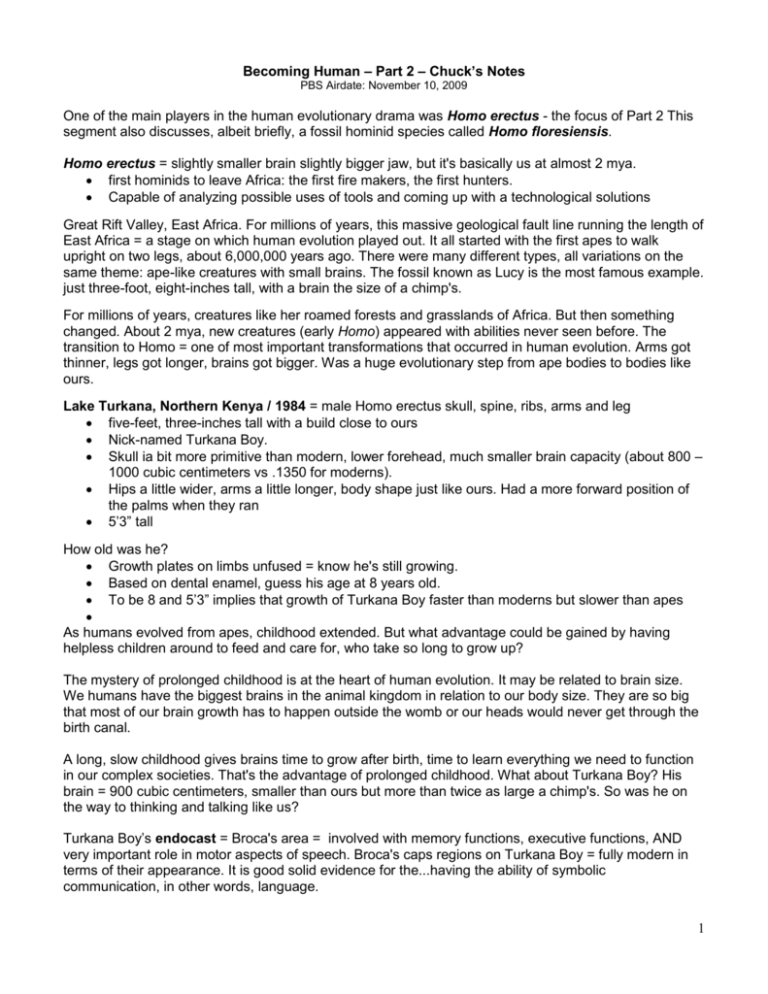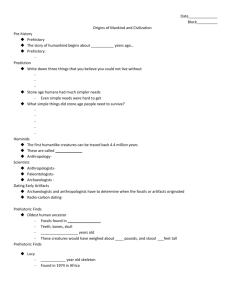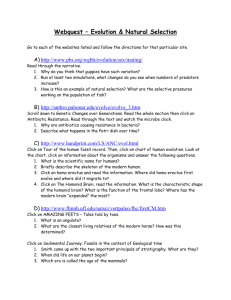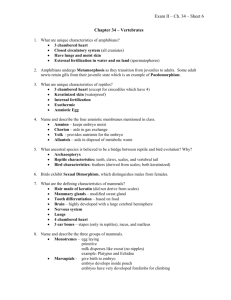Becoming Human – Hour 2
advertisement

Becoming Human – Part 2 – Chuck’s Notes PBS Airdate: November 10, 2009 One of the main players in the human evolutionary drama was Homo erectus - the focus of Part 2 This segment also discusses, albeit briefly, a fossil hominid species called Homo floresiensis. Homo erectus = slightly smaller brain slightly bigger jaw, but it's basically us at almost 2 mya. first hominids to leave Africa: the first fire makers, the first hunters. Capable of analyzing possible uses of tools and coming up with a technological solutions Great Rift Valley, East Africa. For millions of years, this massive geological fault line running the length of East Africa = a stage on which human evolution played out. It all started with the first apes to walk upright on two legs, about 6,000,000 years ago. There were many different types, all variations on the same theme: ape-like creatures with small brains. The fossil known as Lucy is the most famous example. just three-foot, eight-inches tall, with a brain the size of a chimp's. For millions of years, creatures like her roamed forests and grasslands of Africa. But then something changed. About 2 mya, new creatures (early Homo) appeared with abilities never seen before. The transition to Homo = one of most important transformations that occurred in human evolution. Arms got thinner, legs got longer, brains got bigger. Was a huge evolutionary step from ape bodies to bodies like ours. Lake Turkana, Northern Kenya / 1984 = male Homo erectus skull, spine, ribs, arms and leg five-feet, three-inches tall with a build close to ours Nick-named Turkana Boy. Skull ia bit more primitive than modern, lower forehead, much smaller brain capacity (about 800 – 1000 cubic centimeters vs .1350 for moderns). Hips a little wider, arms a little longer, body shape just like ours. Had a more forward position of the palms when they ran 5’3” tall How old was he? Growth plates on limbs unfused = know he's still growing. Based on dental enamel, guess his age at 8 years old. To be 8 and 5’3” implies that growth of Turkana Boy faster than moderns but slower than apes As humans evolved from apes, childhood extended. But what advantage could be gained by having helpless children around to feed and care for, who take so long to grow up? The mystery of prolonged childhood is at the heart of human evolution. It may be related to brain size. We humans have the biggest brains in the animal kingdom in relation to our body size. They are so big that most of our brain growth has to happen outside the womb or our heads would never get through the birth canal. A long, slow childhood gives brains time to grow after birth, time to learn everything we need to function in our complex societies. That's the advantage of prolonged childhood. What about Turkana Boy? His brain = 900 cubic centimeters, smaller than ours but more than twice as large a chimp's. So was he on the way to thinking and talking like us? Turkana Boy’s endocast = Broca's area = involved with memory functions, executive functions, AND very important role in motor aspects of speech. Broca's caps regions on Turkana Boy = fully modern in terms of their appearance. It is good solid evidence for the...having the ability of symbolic communication, in other words, language. 1 Never know if Turkana Boy could speak. But are other clues to his intelligence: stone tools he left behind. Homo erectus made tools = hand axes = chipped extensively on both sides = very, very versatile tools point enables one to do piercing tasks heavy bit here can be used for cracking bone or chopping wood. It's a Stone tools represented a momentous change once have stone tools = all the foods in the world could open up to you = tremendous survival advantage. When making stone tools, H. erectus recognize flaws in raw material – understood properties of stone SIGNIFICANCE: capable of thinking ahead and planning consequences of their actions. Homo erectus’ bigger brain came with hidden costs. Modern brains consume 25 % of our body's energy. a Homo erectus like Turkana Boy needed more nutrition from his savanna environment. Turkana Boy, had he grown to adulthood = probably have stood about six feet tall had a huge energy budget. can satisfy an energy budget by eating plants, but you have to eat a lot, a lot of plants. But there's one food that can supply the nutrients a growing brain and body need: meat and meat byproducts, such as brain and marrow and fat How did H. erectus get meat? One hypothesis: endurance running and high activity in the middle of the day Unlike the Australopithecus people, Turkana Boy's kind were built to run, like us H. erectus had lost thick coat of body hair / keep cool by sweating = key to their success How do we know if these crucial changes go back all the way Homo erectus? Especially since skin and hair are rarely preserved in the fossil record look at the louse = it’s been intimately connected with hair for a long time Humans have one kind of louse on their heads and another in the pubic area: why? when we had body hair all over our bodies, we had one type of lice. But then we became hairless until only had hair on our heads and in our pubic region, and so, therefore, you would have this sort of hairless geographic barrier to contact between the two. human pubic louse is very different from the human head louse. Somehow, in the past, it seems to have come from gorillas. How it is our ancestors got pubic lice from gorillas scenario is that when we lost our body hair, the original human louse migrated to our heads, leaving the pubic area temporarily unpopulated by lice. When our ancestors had contact with gorillas, gorilla louse colonized pubic region. Eventually it turned into the human pubic louse of today. When did human pubic louse and the gorilla louse diverged = molecular clock estimated date for divergence = about 3 mya SIGNIFICANCE: long before Turkana Boy, maybe even around Lucy's time, our ancestors had slowly begun to lose their body hair. Turkana Boy was mostly hairless = may be what allowed him to actively hunt down game. Most animals at a disadvantage in the midday sun because they overheat. They can only cool down by panting. when they run fast they can't pant. 2 That means they can only run in short sprints. But hominids can cool down by sweating Our hairless bodies allow air to circulate freely on our skin and cool us down as sweat evaporates. Makes us one of best long-distance runners in the animal kingdom. Hypothesis = sweating gave our ancestors the ability to hunt in a very unusual way persistence hunting. Modern ethnographic record can show how it was done. !Kung san hunters of the Kalahari At midday animals rest in the shade = perfect time to be hunting. Once locate prey = run it to exhaustion. Every time animal tries to rest, get it moving again / never give it a chance to cool down If the theory is right, the Bushmen hunt may help explain how Turkana Boy got his meat. Homo erectus probably hunted with close-quarters weapons spears thrown at animals from a short distance, clubs, thrown rocks Society is in every corner of our lives. What's behind it? Why did we become so social? Could it have something to do with another innovation, something unprecedented in our evolution: building fires and cooking? Earliest evidence our ancestors deliberately used fire for cooking dates to long after H. erectus. But Homo erectus was probably using fire for a variety of purposes protect themselves at night from wild animals and maybe cooking - which makes food more soft and digestible Which might explain why Homo erectus evolved smaller teeth and a much smaller gut. Fire also brought us together - we became more social More time for sharing and communicating sitting around fires (maybe waiting for food to cook) DISCUSSION OF MATERNAL COMMITMENT AMONG HUMANS Human babies need large capacity to read the intention of others human mothers abandon their infants much more often than ape mothers. Infanticide by a mother is more common among humans than any other higher ape. Maternal commitment is a lot more contingent in humans than it seems to be in other apes. Unlike most primates, human mothers share parenting with others. A child's survival can depend on making itself appealing to a number of caregivers. Perhaps that's why human infants have evolved a uniquely acute sensitivity. Human infants are born connoisseurs of mothers, reading her facial expression, looking for signs of commitment We are born hard-wired with an awareness of the intentions and emotions of others, which is unique in the animal world. When did humans develop this gift for attributing mental states and feelings to others and for caring about what others thought about them? 3 Perhaps these social instincts developed with Homo erectus Along with cooperative hunting, bigger brains, longer childhoods and the use of fire? Perhaps H. erectus were intelligent social beings with an increasing capacity for cooperation. May be this made possible another great achievement = the exodus from Africa. For millions of years, our earliest ancestors stayed in African = but at some point started to leave Fossils and tools found as far away as China (at 1.3 mya) and Indonesia (1.8 mya) Question: when AND why did they leave Africa? For decades, scientists believed H. erectus left Africa a million years ago. But migration may have started a lot earlier. Dmanisi, Georgia (in the Caucasus mountains) = fossils found there are about 1.8 mya site turned up a treasure trove of early Homo (erectus?) fossils. transformed our understanding of who left Africa and when. showed that the first humans to leave Africa were much more primitive than Turkana Boy. At four and a half feet tall = smaller than Turkana Boy, with more ape-like shoulders and a simple stone technology, have small brains Scientists now accept that as soon as Homo (erectus?) appeared = started to leave Africa Perhaps even before appearance of Homo erectus. Five thousand miles from Africa: the island of Flores, Indonesia bones of a tiny human, just over three feet tall, called Homo floresiensis = the Hobbit Endocast is roughly 400 CCs = barely bigger than brain of Lucy foot's primitive, hand's primitive, leg is primitive, lower limb much like Lucy’s stone tools (something Lucy never had). Everything about floresiensis is an enigma. Where did they come from and what were they? Some = just a dwarfed population of modern people – suffered from some disease Others = evolved from Homo erectus = "island dwarfism" Still others = descended from more primitive ancestor? What would push and/or pull early Homo out of Africa? PERHAPS a climate shift which spread grasslands from Africa into Asia; with the grasses went the game animals. Animals are going out of Africa, the hominids will keep pace with those animals. Of course, our ancestors didn't know they were leaving Africa. They just followed the animals Process probably very, very slow imagine a group of Homo erectus moving their range a kilometer a year in one direction. And doing that continually over a long enough period of time, you can get the distance from Africa to Indonesia covered in say, 15,000 years. By a million years ago our ancestors had populated Asia from the Caucasus to Indonesia. And they were in Europe too, as a recent discovery in Spain has shown Homo erectus longevity was astonishing. A few pockets of Homo erectus may have been still clinging on in Asia just 50,000 years ago. What was the secret of Homo erectus' success? Dmanisi given us one clue. 4 One of skulls = old man. His jaw bone = lost all his teeth, well before he died. this individual survived two years without teeth. must mean others in the group were feeding him This was a remarkable testimony from the past about the quality of emotional life that may have characterized Homo erectus. 5








